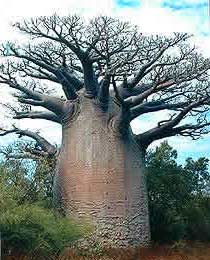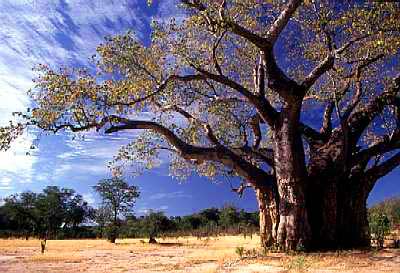 |
|
Photo: Baobabs.com |
On the tropical savannahs of East Africa, there is the Baobab tree, known for its unique shape. With a circumference of about 50 meters, it takes around 40 people holding hands to encircle the tree; its height is just over 10 meters. This is why it is commonly referred to as the “fat tree.”
The Baobab is a medium-sized tree belonging to the Bombacaceae family, native to the arid regions of Africa. During the dry season, to reduce water evaporation, the tree sheds all its leaves to adapt. When the rainy season returns, its porous trunk absorbs a significant amount of water for storage. It has been recorded that a Baobab can absorb up to 450 kilograms of water, clearly making it a water tower in the barren savannah. Once fully hydrated, the tree sprouts palmate compound leaves and blooms with white flowers. Its fruits are elongated like fingers, and their woody shells can store water or even alcohol. The flesh of the fruit is delicious, juicy, and very refreshing, making it a favorite food of monkeys and apes, hence it is often called the “monkey bread tree.”
Leaves, fruits, and bark of the Baobab can all be used for medicinal purposes. Consuming young leaves can help prevent scurvy and rickets. The bark is rich in fibers, which can be used to make textiles, baskets, ropes, or paper.
Interestingly, the Baobab is a “hollow” fat tree; during the summer, it can serve as a place for respite, while during the rainy season, it provides temporary shelter for lions and zebras.
Baobabs have a remarkably long lifespan, living approximately 4,000 to 5,000 years.
 |
| Baobab in Zimbabwe (Photo: Natureworkshop) |


















































